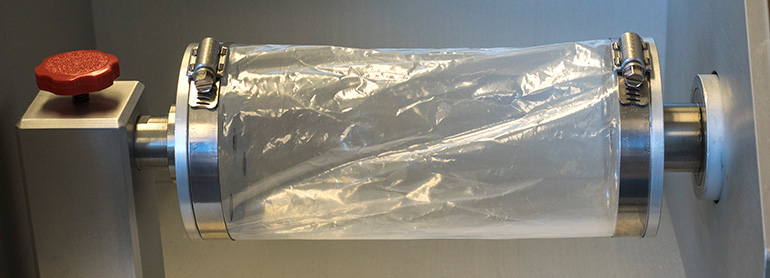Using Gelbo Flex Testing to Determine Flexible Material Durability

Three Parameters to Consider
14 June 2016
If you have been performing property evaluations on flexible film materials using single point tests such as impact, puncture, tear, and tensile, consider a dynamic end-use test for durability, instead. Gelbo flex testing can upgrade an annual characterization, evaluate the competition or benchmark claims in the industry.
During the Gelbo test, thin flexible materials are repeatedly twisted and crushed at 45 cycles per minute. Flex failure is determined typically by evaluating pinholes or other diminished properties. The test is demonstrated in this short video.
The standards used for Gelbo Flex Testing can vary, but one commonly used is ASTM F392. Following are three parameters to consider when conducting Gelbo flex testing under this standard.
1. Number of Cycles
There are five common conditions for the Gelbo testing, ranging from Condition A (2700 cycles) to Condition D (20 cycles) for full flex cycles and Condition E (20 cycles) for a partial flex cycle. The test for each is application- and film-dependent. To determine how many cycles will be needed, consider the following:
- A common metalized snack bag will most likely not see failures even at Condition A (2700 full cycles)
- A clear snack bag may see failures at the seal at Condition A (2700 full cycles)
- Flexible composite webbing may start to show failures in the form of delamination at Condition D ( 20 full cycles)
2. Samples and Controls
Sample management is the key to acquiring accurate data. The ASTM standard requires controls; film may be tested in both directions. A control may identify quality issues at the processing level. Directionality (machine and transverse) of film can also exhibit deviances in durability. Keep in mind, seams may be considered for evaluation as well. In the end, be prepared to provide control specimens, identified seams for evaluation (if required) and clearly identify direction of film/packaging.
3. Evaluations
Evaluations are conducted after the film has been subjected to Gelbo flexure. A dye wash to determine pinholes is typical for this test. During this procedure, a red dye is brushed over the flexed specimen and a blank sheet of paper is placed under the specimen to be evaluated for ink bleed. A finding of more than 50 pinholes per 300cm2 is considered significant. The pinhole method may just be enough to discover if durability has been compromised. A barrier test such as water vapor transmission rate may also be used to determine breakdown. After evaluations are complete, it may be helpful to request the samples back from the lab to review the types of failures such as rips, tears and general damage.
With the addition of dynamic tests such as Gelbo flex testing to material evaluation programs, substantial discoveries may come to light about the durability of film. The test demonstrates how properties diminish upon repeated flexure -information that is useful when evaluating the competitive landscape or benchmarking claims in the industry. Gelbo flex may be a welcome addition to your next film characterization program.
Kimberly Stuart is Marketing Manager for Plastics and Composites Services at Intertek. The creator of Testlopedia®, a free online encyclopedia of plastics and composites testing, she regularly presents webinars on testing for the building, medical, transportation and packaging industries. After receiving a BA in Business Management from Eckerd College, she attended the graduate program at UMASS Lowell for Plastics Engineering.
Tags: 2016 | Kimberly Stuart | Product Design

Kimberly Stuart,
Marketing Manager for Plastics and Composite Services


